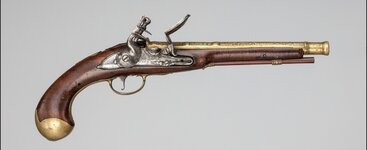I'm gonna yap here for a bit of fun.
Any manga enjoyers feel free to skip my digressions. TLDR: Musketry lore.

As I mentioned before, flintlock muzzle loaders and similar firearms contrary to popular belief are relatively accurate. But if they were accurate, why would people continue to fight linearly? And why is the belief that they are innaccurate prevails?
People fought linearly since it was the most efficient way to control a large number of people. By having everyone in a big group you could communicate orders efficiently and quickly. If everyone was spread apart, whilst it would be more effective to take cover and return fire, orders would be more difficult to communicate due to the distance between individuals. This also presents vulnerability to cavalry and melee charges.
As you mentioned, bayonet charges were a popular tactic in linear warfare (though it became less popular and less effective as guns and tactics became more efficient, such as in the American civil war). Bayonet charges however were not the main method of dealing casualties. In fact most bayonet charges would not result in melee combat. As either the attacker would break due to the incoming fire, or the defender would route due to the incoming stabby stab. (Most people would want to not get stabbed after all).
Bayonet charges are used to gain ground and push enemies back. Not as a method to deal casualties because of inefficient firearms. A trained soldier with a flintlock muzzle loader and paper cartiridges should be able to put down 2~3 rounds a minute.
So, back to the question of accuracy; I'd argue that this is due to the shooter more than the firearm. Certainly early renditions of firearms such as the handgonne or arquebus (hence the mentions in the first post) were innaccurate, unwieldy and unreliable; the point of impact differing to the point of aim, lacking buttstocks and requiring an extra aiming fork, suffering from an unreliable and unsafe ignition source (a slow burning match). But flintlocks are a lot more better to the point that many of these factors do not apply significantly and thtat accuracy is dependent on the shooter.
The chaos of combat is a big factor that contributes to this: getting shot at, the fatigue of fighting, fouling of the gun and the constant smoke; it all leads to
less rounds on target. This all applies to modern shooting too. Hence why it may take hundreds or thousands of bullets to hit one guy. In modern warfare, arty and other munitions contribute more to casualities.
In regards to the idea of the
countermarch or firing by volley, as made popular by Oda Nobunaga by his alleged applications (Though we don't know if he actually did). It is not a new idea and has been used throughout history. Other firing drills such as platoon firing also achieve the same result. Using different firing drills may have different effects. Whether you want a constant rate of fire or a big blast all at once.
Overall, I'd argue that the notion of muzzleloaders such as flintlocks being ineffective weapons being a false stereotype. Are they innaccurate? No. Are they unwieldy? way less than their predecessors. Are they a pain to reload? Not as bad as you think. They are relatively accurate and can be fast to reload with paper cartridges. The conditions of its usage is what determines its effectiveness.
Anyways thanks for reading my ted talk.



